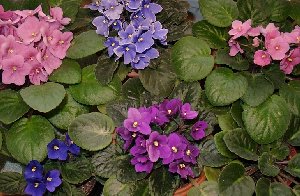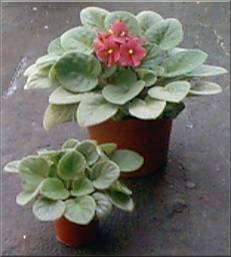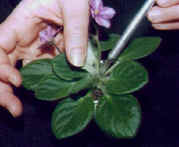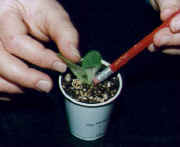|
Plants for your home
(By Mary Efanti)
Saintpaulia
 Description - Origin Description - Origin
Saintpaulia, commonly known as African violet, is one of the most commonly seen plants given as gifts in tiny
pots. Youíve had at least one of these plants, either in a pot by itself or as part of a plant
combination.
Saintpaulia was discovered back in 1892, in what we now know as Tanzania, by a German official called Walter Saint
Paul. He introduced the plant to Germany where it quickly became very popular among flower
lovers. The plant was named Saintpaulia after this man. As its flowers resemble the violet
flowers, its common name ended up being African violet. The plant was hybridized in 1927 and its cultivation
started, with many varieties being introduced ever since. The new hybrids had flowers of different colours and leaf
shape. The plant was introduced to the USA around 1940 and many new varieties were created in this continent as
well.
It is a very popular plant as it is small, beautiful and blooms all year round if the conditions are
suitable. Moreover, its low cost made it one of the most favorite plants.
You will recognize it by its velvety hairy leaves and its delicate flowers that come in every
shade, from white to dark purple. Recently bicolor varieties were also introduced as well as varieties with flowers of different color on the same
plant.
Care
Saintpaulia is one of the most common plants for the home as itís care is rather
easy. This is an indoor plant only as it cannot withstand the low temperatures of
winter.
Its greatest advantage is its ability to adapt to the environment of most homes and because of its small
size, it is an ideal plant for little space as it can grow on window sills or small coffee
tables.
The basic requirement for the plant to do well is lighting. Saintpaulias need plenty of light that should be always
filtered. Do not let the plant sit in direct sunlight as its leaves will get sunburned and the plant will die
back. If its leaves get thin and their stems are long, this would indicate that the plant is not getting enough light so it grows leggy in order to get closer to the light
source. The ideal lighting position would be next to a north or east
window. To avoid leggy plants, rotate the pot by 45Ô every time you
water.
Saintpaulia can grow as well in places that do not have any natural lighting as long as it gets enough artificial
light. That should be at about 600 candles and for at least 15 hours a
day. The 600 candles intensity would be two 40W lamps at a distance of 30-35cm from the
plant.
The average temperature of our homes is satisfactory, the ideal temperature though should be 18-20oC but as we already
said, given time this plant will adapt to our homeís conditions. The difference of
day-night temperature should not be more than 8-10 degrees. It would be helpful if you could close the blinds at night or place a piece of carton between the window and the plant to prevent
freezing. Saintpaulias can not withstand freezing temperatures, if it freezes it will turn brown within 24
hours, will start to rot and will die very soon.
At very high temperatures in summer, the development of the plant will slow down or even get
stalled. To this end, it would be advisable to move your plants in cooler or
air-conditioned rooms. In this case try to place them away from the direct draft of the
airconditioner.
 Saintpaulias also require a high humidity. Raise the humidity, especially in winter when the heating is
on, either by using a humidifier or by placing the pots on trays of wet gravel or
sand. Make sure the pots do not sit in water.
Saintpaulias also require a high humidity. Raise the humidity, especially in winter when the heating is
on, either by using a humidifier or by placing the pots on trays of wet gravel or
sand. Make sure the pots do not sit in water.
If you decide to repot, the soil should be light and rich in organic elements. You should also make sure it has excellent drainage because saintpaulias will rot if they are
waterlogged. The ideal soil should contain houseplant soil-mix, peat moss and perlite in equal
parts. Also it should be rather acidic (pH 6.0 Ė 6.5).
The ideal pots for saintpaulias are those made of plastic, available in small
sizes. If you want to use decorative pots, it would be better to use them as
cas-pots and place the plastic pots inside them. When you repot use only one size larger pots because these plants need to be root bound in order to
bloom. As the leaves of this plant are very tender and break easily, do not water the plant for 2-3 days prior to repotting so the leaves will wither a
bit. This would make the plant easier to handle. Another good tip is to place some aluminum foil or tape at the edges of the pot
(especially on clay pots) so that the leaves do not lean on the damp pot and rot. Repot only in spring and only when the plant has become too big for its
pot.
Watering saintpaulias must be done with care. Although the frequency of watering greatly depends on the soil and the size of both the plant and the
pot, it is important to avoid over watering. Too much water can cause root rot while too little water can dry out and damage the root
system. Water only when the surface of the pot feels dry to the touch. In
general, remember that when it comes to watering less is better.
Saintpaulias must be watered from the bottom, by filling the tray with tepid or room temperature
water. Let the pot absorb as much water as it needs. Then empty the remaining water from the tray and let the pot
drain. Make sure to empty the tray again in a while. As watering from the bottom can cause salt accumulation on top of the
soil, try doing a thorough watering from the top once a month so that the accumulated salts are drained
away. Each time you water, avoid wetting the leaves or the flowers. If by mistake you wet the
leaves, wipe the water away immediately. If you insist on cleaning the leaves of the
plant, you should rather use a soft brush and be very careful.
Saintpaulias do need fertilization. In this case as well, less is better. Take a good look at the plant in order to identify whether it needs any
fertilizer. If you notice the plantís growth slowing down and the leaves getting lighter in
color, this would be the time to add some fertilizer. Do not fertilize at all during winter as the plant needs a rest and its development is normally much
slower. Use a liquid fertilizer for flowering houseplants and follow the instructions on the
label. In average, saintpaulias will benefit from fertilizing 2 times a month, from spring till late
autumn.
Propagation
The easiest way to propagate saintpaulias is through cuttings. Choose mature but not old or withered
leaves. Cut them off the mother plant and use rooting hormone or a glass of water so they can develop roots and be
transplanted.
 If you use a glass of water, cover the top of the glass with aluminum foil or a sheet of plastic and make tiny holes on it so that the stem of the leaf is into the water but the leaf itself is
not. Be patient and change the water when it starts to get yellow. The roots will appear in 4-6 weeks and new growth will develop in about another 4-8
weeks. That would be the time to transplant the new plant into a separate pot.
If you use a glass of water, cover the top of the glass with aluminum foil or a sheet of plastic and make tiny holes on it so that the stem of the leaf is into the water but the leaf itself is
not. Be patient and change the water when it starts to get yellow. The roots will appear in 4-6 weeks and new growth will develop in about another 4-8
weeks. That would be the time to transplant the new plant into a separate pot.
 Moreover, you could divide the mother plant when you decide to
repot. In this case use a sharp knife and carefully divide the plant in such a way that each part has part of the mother plantís root system
attached. Transplant the parts in separate pots and cover them with plastic Ė remember however to make aeration holes on the
plastic. This cover will maintain a high level of humidity and keep your plant from withering until its new root system is
developed. Moreover, you could divide the mother plant when you decide to
repot. In this case use a sharp knife and carefully divide the plant in such a way that each part has part of the mother plantís root system
attached. Transplant the parts in separate pots and cover them with plastic Ė remember however to make aeration holes on the
plastic. This cover will maintain a high level of humidity and keep your plant from withering until its new root system is
developed.
You could also buy seeds and start your own plants from scratch but this would be a slow and difficult
process.
Get yourself a saintpaulia. Itís small and beautiful, not expensive to buy and rather easy
care. It will take so little of your space and offer you beautiful small flowers all year
round. Good luck!
Mary Efanti
[email protected]
|
